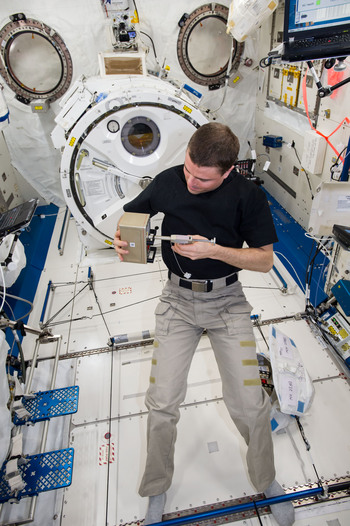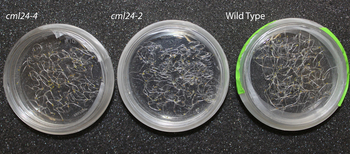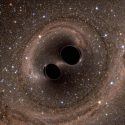UW team’s plants return to Earth after growing in space
Botany professor Simon Gilroy (left) and postdoctoral researcher Won-Gyu Choi unwrap four canisters of plants packed in dry ice. The plants grew aboard the International Space Station and were returned to Gilroy’s lab today.
Photo: David Tenenbaum
Researchers at Simon Gilroy‘s lab in the Department of Botany at the University of Wisconsin–Madison this afternoon greeted a truck carrying small containers holding more than 1,000 frozen plants that germinated and grew aboard the International Space Station.
On Tuesday, when Gilroy’s team inspected the plants at the Kennedy Space Center in Florida, they saw exactly what they wanted: Petri dishes holding seedlings that sprouted and grew in weightlessness.
After their arrival in Madison, the plants went directly into a deep freeze. After being thawed in a few months, they will donate their RNA to an instrument that will measure the activity of all of their approximately 30,000 genes.

Astronaut Reid Wiseman injected a fixative solution onto the seedlings.
Photo: NASA
Half of the plants will become subjects in Gilroy’s longstanding exploration of the genetic control of the proteins that enable plants to grow in zero gravity. “Gravity is a fantastically pervasive force that affects all biology,” says Gilroy. “One astronaut observed that plants get lazy in a weightless environment; they grow long and thin, and don’t lay down strong material, just like people lose bone mass in space because it isn’t needed for supporting weight.”
The other half of the experiment represents a departure for Gilroy, and for NASA, the agency supporting this area of space research. After these plants undergo a similar genetic analysis at UW–Madison’s Biotechnology Center, the data will get an initial check-over from Gilroy’s group. And then a treasure trove of digital data on plant genetic activity in microgravity will be made available to any researcher interested in mining it.
“Access to space is very rare,” Gilroy says. “Traditionally, a research group will put an experiment in space, get the results and publish. But NASA is trying a new mode, called geneLAB, where the research group will put organisms in space, then, as soon as possible, release the raw data to anyone who wants to analyze it. They hope it will speed up major advances on these tiny samples that we can afford to place in space. I see this as open-source science.”
Through the process called transcription, genes produce RNA that becomes the template for proteins, and in both sets of experiments, the RNA data will show which genes become more or less active in microgravity, when compared to an identical set of plants grown on Earth.

Samples of Arabidopsis plants identical to those that grew in space.
While Gilroy plans to focus on structural proteins, the geneLAB experiment compares four variants of Arabidopsis called ecotypes. “This data should provide a broad field of investigation — far more than one lab can handle,” Gilroy says. “We are going to end up with an enormous amount of transcription data. We will do some initial work to check the major genes which go up or down, but there’s tremendous potential for further analysis by other labs around the world.”
But while the geneLab approach sounds promising, Gilroy concedes that it carries no guarantees. “This may be a path forward in crowd-sourcing science. At the least, as a single lab we could never analyze this data as fully as many labs around the world all working with it.”
The “Biological Research in Canister” containers that held these experiments on board the space station were designed, tested and operated according to NASA’s rigorous approach, Gilroy says. “Each project represents an enormous investment, and you really want everything to go perfectly. You become one of the most careful scientists in the world. You test everything, make duplicates, and are always considering what may go wrong so you can do another test.”
Won-Gyu Choi settles four canisters of plants grown aboard the International Space Station into a -80 degree Celsius freezer in Birge Hall.
Photo: David Tenenbaum
NASA is an unfamiliar world to most botanists, but Gilroy seems to be enjoying every step of the way, and has even learned the organization’s peculiar parlance. “At first, talking in acronyms is very strange,” he says, “and you can’t understand anything when NASA people start going into NASA-speak. But once you get into it, you catch yourself doing the exact same thing.”
In the microgravity experiments, Gilroy is exploring the genetic basis of a phenomenon known to gardeners and horticulturalists for many years. Plants that grow up without mechanical stresses — due to wind, rain or other disturbances — “are much more susceptible to pests, are not as robust,” Gilroy says, “but if you go into a greenhouse and shake the plants, they grow up more compact, strong, and resistant to stress. They are even more resistant to plant diseases.”
It turns out that the same signaling system used to detect mechanical stresses like gravity is also used to defend against pathogens. That may explain why plants in space appear more susceptible to disease.
That overlap raises the stakes for understanding the impact of gravity on plants beyond the notion of building stronger crops that can stand up in the field. Understanding the signals could help in the never ending battle against plant disease.
Likewise, NASA has its own practical interest in the research: Plants will supply food and oxygen for long-distance space travel, and keeping them healthy will be a matter of life and death. “If you are growing plants as part of a human life support system,” Gilroy says, “you’d rather not have them suddenly die.”
Tags: biotechnology, plants, research, space & astronomy


